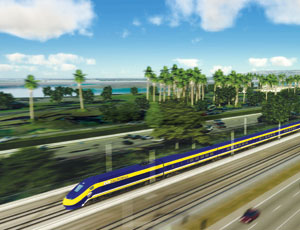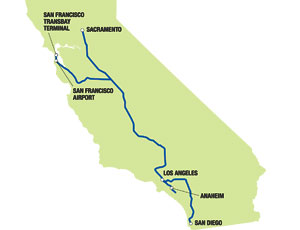Call it a double-edged sword, a perfect storm or—stealing a quote from Charles Dickens—American Public Transportation Association President William Millar describes the state of transit as, “The best of times, the worst of times.” From California to the Carolinas, the acceptance of and desire for transit systems is unprecedented. Voters in November approved more than 20 pro-transit ballot initiatives, most notably Proposition 1B in California that calls for $9.95 billion for a high-speed rail system stretching from Sacramento to San Diego.
But transit owners, designers and builders have no easy task ahead. The “pain at the pump” that helped prompt more Americans to turn to transit also is proving to be a pain for transit providers. “Our members used 6% of their operating budgets on fuel three years ago,” says Millar. “Now it is 11%.” Moreover, sales-tax revenue is down due to the economic crisis.
Nevertheless, many believe transit’s time has arrived. APTA statistics show 10.3 billion transit trips were taken last year—the most in 50 years. Ridership grew by 3.4% in the first quarter of 2008 and 5.2% in the second. Jerome Premo, head of AECOM’s North American rail group in Los Angeles, believes this is part of a global trend. “There are unprecedented developments in Australia, the Middle East, China,” he says. “This is a big deal.”
Premo is not alone. “I think you’re going to see an unprecedented investment in transit,” says Tom Warne, founder of Tom Warne and Associates, LLC, South Jordan, Utah. “You have a political climate in Washington that appears to be more friendly for transit. You have the aftereffects of the $4-a-gallon gas prices, and that was a wakeup call for people. Even though [fuel prices have] gone down, the numbers don’t show anyone reverting back to driving more miles.”
Officials hope some “unprecedented investments” will come from an economic stimulus package and/or private partners. Voters in traditionally automobile-dependent states like California did their part in November, but that is not enough.
Golden State of Transit
Rick Thorpe, CEO of the Exposition Metro Line Construction Authority Board in Los Angeles, expects to be busier than ever. The eight-mile $860-million Exposition light-rail line is under construction, slated for a December 2010 completion. Since Los Angeles voters approved Measure R, a half-cent sales-tax increase, there now is funding for a $1.6-billion extension to Santa Monica.
A draft environmental-impact statement is wrapping up for that two-phase project, says Thorpe. A $900-million extension of light rail from downtown Los Angeles to East Los Angeles is due to open next June. With the passage of Measure R, “we’re pretty much able to build out our rail program,” Thorpe says.
Construction starts this month on San Francisco’s Transbay Terminal, a $4.1-billion project to build a six-story structure that will house up to eight transit systems, including a high-speed rail system that planners had long dreamed of. “We’re excited that California voters passed this, especially during hard economic times,” says Ken Jong, San Diego-based engineering manager for Parsons Brinckerhoff, program manager for the California High-Speed Rail Authority. “It reignites the planning process for an 800-mile system into environmental review and preliminary engineering.”
Finding state, federal and private funding is the next challenge. About $40 billion is expected from Measure R over its 30-year life, says David Yale, deputy executive officer of regional programming for the Los Angeles County Metropolitan Transportation Authority. But some projects may be delayed, he warns. “Due to the economic downturn...we’re going to have to make some choices about which of these come first,” Yale says.
As for high-speed rail, approving the $9.95-billion bond measure is only the first step, says Quentin Kopp, chairman of the California High-Speed Rail Authority. The project cannot begin until state officials certify that enough money is available to complete it, he says. The authority will seek up to $17 billion of federal funds and is looking at “essential” private partnerships that would fund up to $7.5 billion, Kopp says. Operational costs would be about $2.1 billion a year, with $3.2 billion expected in revenue.
Orange County Transportation Agency officials also are talking with federal and private partners about funding for a planned Anaheim Regional Transportation Intermodal Center. ARTIC is seen as a southern terminus for the high-speed rail project. OCTA has bought the land for the site and would like to see work begin by 2010, says Art Leahy, its chief executive officer. But it may delay the project if federal funding cannot be found or if a better deal can be made with a private partner in the future, he says. “We are going to be careful, with the state of the economy now,” Leahy says. “We know right now is not the best of economic times.”
| ARKANSAS: $130,000/year for five years to establish a Jonesboro transit agency. |
| CALIFORNIA: $10 billion for San Francisco-Los Angeles high-speed rail; $40 billion over 30 years for Los Angeles County projects, $45 million/year for Sonoma-Marin rail projects. |
| COLORADO: $38 million of bonds for bus rapid-transit system in Aspen |
| HAWAII: Start of a $3.7-billion, 20-mile light-rail line in Honolulu. |
| KANSAS: Three sales taxes for streets and public transit in city of Lawrence. |
| NEW MEXICO: $19 million/year in tax rev-enue, half for New Mexico Rail Runner Express. |
| RHODE ISLAND: $87.2 million of bonds for transportation, including $7.2 million for transit. |
| WASHINGTON: $17.8 billion over 20 years for transit, including 34 new miles of light rail. |
| WISCONSIN: 1% sales tax for $130 million/year to pay for various services, including transit. |
| SOURCE: CFTE |
On the other side of the country, New York City’s Metropolitan Transportation Authority pushes on with several multibillion-dollar transit projects even as it struggles with budget woes. A report from a commission led by former chairman Richard Ravitch, due on Dec. 5, will likely suggest more tolls and fare increases to plug a $1-billion annual budget gap.
Michael Horodniceanu, is the new president of MTA’s Capital Construction Co., which is managing the $6-billion East Side Access project, $4-billion Second Avenue Subway first phase, $900-million Fulton Street Transit Center and $2-billion Seven Line extension. He does not anticipate schedule delays. “We’re looking at our 2010-2014 plan now and working with funding partners,” he says.
In the meantime, Horodniceanu cites efforts to minimize costs. The planned $420-million Fulton Street Transit Center station received one bid of $870 million last year , and the project was broken up into smaller packages. The new foundations package had six bidders, all within 10% of the revised $62-million estimate. Horodniceanu expects the mezzanine contract to go through Requests for Proposals in 2009. The fate of the planned oculus dome is still up in the air. “I’d not say it’s doomed,” he says. “Everything is being discussed.”
“We’re working with all our contractors to determine...better terms and conditions,” Horodniceanu adds. “Sometimes we can be guilty of placing too much risk on the contractors, and we pay the price.” He says MTA is looking at escalation clauses for materials costs, separating utility packages from general contracts and buying items in bulk.
Aside from New York and California, Seattle may have the biggest transit capital program planned. Voters passed a $17-billion transit bond issue. Some of it will pay for a 36-mile extension of a light-rail line due to open this summer, from downtown Seattle to the airport.
About $6.5 billion of bonds will be sold in 2009, says Linda Robson, Sound Transit spokesperson. “We are not anticipat-ing any difficulty selling AAA-rated bonds. While the borrowing rate is a bit higher in today’s market than the historical average, it is expected to average out over the 15-year period.”
Other growing transit agencies also are confident of long-term positive economic health. Keith Parker, CEO of the Charlotte Area Transit System (CATS), says...













Post a comment to this article
Report Abusive Comment